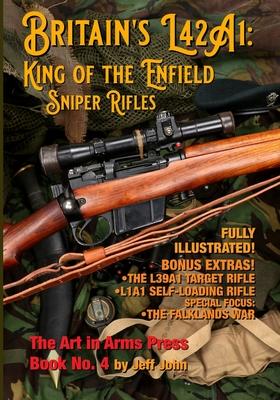
Because the story of L42A1 is intertwined with target shooting and the British Army's switch to a self-loading rifle, the story of the L39A1 target rifle that led directly to the L42A1 and the L1A1 (an inch pattern version of the Belgian designed FN/FAL) are covered in detail along with much of the equipment fielded in this Cold War era.
While the corps of successful scout/snipers of WW II and Korea had been disbanded by the Army in the late 1950s, the Royal Marines kept their concepts alive using the old .303 sniper alongside their modern 7.62 Self Loading Rifles.
Military Match Shooting was very popular in England in the post-WW II era. In the early 1960s as stocks of .303 ammo began running out, the target shooters looked to convert their .303s to 7.62, but RSAF Enfield faced considerable troubles converting the No. 4 from .303 to 7.62, and finally succeeded with the L39A1. When the Army finally remembered the value of a capable man delivering a precise single shot was still a necessary part of a modern military, it needed a sniper rifle in a hurry. Enfield began converting the old WW II sniper rifles using the techniques pioneered with the L39A1. Voil! The L42A1 was born.
The rifle in this book last served with the 7th Gurkha Rifles in the Falklands Island War in 1982 and that conflict serves as the background for the detailed review. If you ever wondered what interplanetary war might be like, a study of the Falklands conflict is a good place to start! The last part of the book contains much information on the difficulties encountered in the Falklands War illustrated by period photos from the Imperial War Museum in the UK. More than 100 color photos illustrate the chapters on the three rifles!
Because the story of L42A1 is intertwined with target shooting and the British Army's switch to a self-loading rifle, the story of the L39A1 target rifle that led directly to the L42A1 and the L1A1 (an inch pattern version of the Belgian designed FN/FAL) are covered in detail along with much of the equipment fielded in this Cold War era.
While the corps of successful scout/snipers of WW II and Korea had been disbanded by the Army in the late 1950s, the Royal Marines kept their concepts alive using the old .303 sniper alongside their modern 7.62 Self Loading Rifles.
Military Match Shooting was very popular in England in the post-WW II era. In the early 1960s as stocks of .303 ammo began running out, the target shooters looked to convert their .303s to 7.62, but RSAF Enfield faced considerable troubles converting the No. 4 from .303 to 7.62, and finally succeeded with the L39A1. When the Army finally remembered the value of a capable man delivering a precise single shot was still a necessary part of a modern military, it needed a sniper rifle in a hurry. Enfield began converting the old WW II sniper rifles using the techniques pioneered with the L39A1. Voil! The L42A1 was born.
The rifle in this book last served with the 7th Gurkha Rifles in the Falklands Island War in 1982 and that conflict serves as the background for the detailed review. If you ever wondered what interplanetary war might be like, a study of the Falklands conflict is a good place to start! The last part of the book contains much information on the difficulties encountered in the Falklands War illustrated by period photos from the Imperial War Museum in the UK. More than 100 color photos illustrate the chapters on the three rifles!
Paperback
$28.95